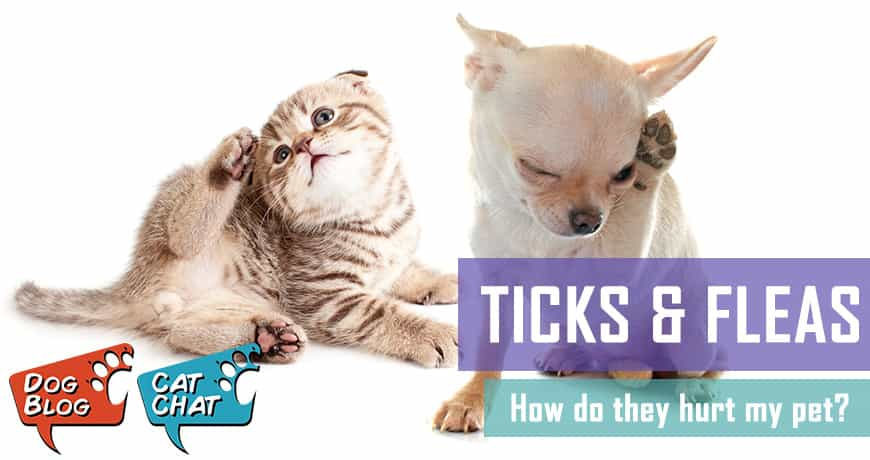How do fleas and ticks hurt my pet?
Fleas
Flea bites can be painful and very itchy. While this might be a minor annoyance to most pets, it can drive some pets crazy with itching, resulting in scratches and sores.
Fleas can cause anaemia. They can consume 15 times their own weight in blood, so an animal that’s infested with fleas runs the risk of losing too much blood, which lowers their red blood cells and causes anaemia. Puppies and kittens, with their lower blood volume, are especially at risk. Signs of anaemia caused by fleas include pale gums and lack of energy. Anaemia can be life-threatening if not quickly treated by a veterinarian.
Some pets develop an allergy to fleas and will get flea bite dermatitis – a reaction in your pet’s skin to the flea saliva. It is common to see flea bite dermatitis on the head, face and neck, or at the base of the tail. Pets with flea bite dermatitis will be very itchy, may lose hair on the affected areas (from all the licking and scratching), and may have red skin or raised nodules and scabs on the itchy areas. Not all animals will become allergic to fleas, but some animals may be so sensitive that they start showing signs of this allergic reaction with the first flea bite. Symptoms of allergies include intense itching, hair loss (especially just in front of the tail), scabs and red, irritated skin, which may lead to skin infections.
All fleas carry tapeworms. When your pet is grooming and eats the adult fleas (remember how good cats are at this?), they also eat the tapeworms. Tapeworms live in your pet’s intestines and can cause problems with nutrient absorption. Over time, the tapeworms shed eggs that you might notice as small grains of rice in your pet’s stool or on the fur around their backside. While most of the heartworm prevention medications treat many kinds of intestinal parasites, they do not treat tapeworms. Still, tapeworms are easy to treat with a different medication from your veterinarian.
Ticks
Ticks are usually active in the warmer months of the year, however, the adults of some species are active even in the winter, so tick and flea medication should be used all year round. Ticks are nasty little creatures that carry quite severe diseases that can be transmitted to dogs and cats.
Here are some general or universal clinical signs that can be associated with tick disease:
Fever: Dogs suffering from severe tick bites may have a fever, which raises their body temperature rapidly. They need immediate treatment to bring the infection under control.
Loss of appetite: Sick dogs aren’t hungry dogs, so if you notice that your normally food-happy dog is barely touching his food, this should be cause for concern. Take him for a vet check-up and get a proper diagnosis.
Sore joints or swollen limbs: Your dog’s reaction to tick diseases may result in joint stiffness, similar to arthritis.
Skin infections: Repeated bites and scratching can cause skin infections over and above diseases from the tick bites.
Lethargy: If your dog is less active or behaving indifferently, it might be an indication that he’s suffering from something. Always check your dog for fleas and ticks when he’s showing any signs of lethargy. It’s also a symptom of anaemia.
Abnormal changes in the blood count: A tick infestation can lower your dog’s red blood count and cause anaemia. This is tough to detect at home, but if your dog appears sick and lethargic, a vet check and blood test should reveal whether he’s anaemic or not.
If you see any of these symptoms in your pet, take him to the vet right away for a proper diagnosis. A lot of pet owners mistakenly think that ticks don’t pose serious health concerns, but it’s worth knowing that tick bites and diseases attack your dog’s immune system, rendering him at risk of many other diseases.
Some specific diseases that ticks can transmit are:
Canine ehrlichiosis
Canine ehrlichiosis is caused by the bacterium Ehrlichia canis, which is present in the brown dog tick. Infection by Ehrlichia canis may not immediately show any warning signs, but if left untreated, this disease could progress to a chronic infection without clinical signs, which can last days, months or years.
Mild signs appear to mimic a vague illness; the most obvious sign of which is weight loss. Severe cases of canine ehrlichiosis that go undiagnosed and untreated can end in death.
Most common signs of canine ehrlichiosis
- Depression or lethargy
- Loss of appetite
- Fever
- Runny eyes and nose (discharge)
- Swollen lymph glands
- Spontaneous nose bleeds
- Bruising (petechiae) on gums and belly
- Lameness or joint pain
Biliary fever/tick bite fever
Biliary is one of the most common diseases in dogs in southern Africa, which affects the liver (horses and cats can also get biliary fever) and causes jaundice-like symptoms, amongst others. Biliary fever is caused by Babesia canis, a tiny parasite that enters a dog’s bloodstream through a tick bite and destroys red blood cells.
Clinical signs of infection
- Fever
- Anaemia (pale mucous membranes)
- Anorexia and depression
- Vomiting
- Dehydration
- Jaundice (yellow mucous membranes)
- Red urine (haemoglobinuria)
- Nervous signs
The ticks that prey on your pet are mainly the yellow dog tick (haemaphysalis elliptica) and the kennel tick (rhipicephalus sanguineus). Both are major transmitters of canine biliary fever. In severe infections, death may occur very quickly – within as little as one day – unless there is an effective response to fast treatment.
In order to prevent your dog from contracting tick bite fever or biliary, your best defense is to keep ticks and fleas off him altogether. Ask your vet about the best parasite prevention medication or topical treatment for your furry family and be sure to apply it or administer it regularly to keep your dogs and other pets healthy.







